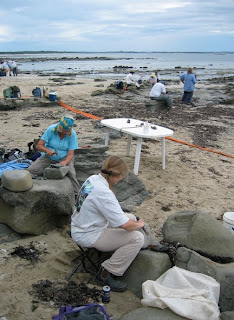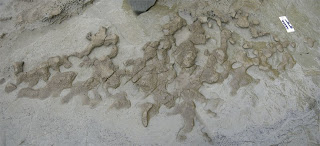
Harmers Haven at low tide.
We went at low tide in the morning, which exposed the rocks along the mostly flat marine platform for kilometers to the east. It was a daunting sight, but we walked to the easternmost end of outcrop and worked our way back, looking for trace fossils and bones. The amount of rock to examine was enormous, and the tide was rising, so not much detailed study could be done of the geology. Within just 2½ hours of arriving, we were driven off the outcrops by the encroaching sea, and had found nothing worth noting. No definite trace fossils or bones were seen, although the rocks did contain a huge amount of carbonized fossil wood, including large chunks of tree trunks.

Fossil plant debris, all shredded and carbonized.

Parts of a fossil tree trunk, with my size 8½ (men's) boot for scale.
Why? How could two paleontologists, one trained in discerning trace fossils and the other in identifying fossil bones, spend hours on a great expanses of Cretaceous-age rocks, yet find nothing more than fossil plant debris? (Not that there’s anything wrong with fossil plants – as my paleobotanist friends will attest.)
The answer is probably related to the science of taphonomy, which is the study of fossil preservation. Sometimes I summarize taphonomy as “everything that happened to an organism after it dies,” but it also can be applied to trace fossils, such as dinosaur tracks or crayfish burrows, which require special conditions to get preserved in the fossil record.
Body fossils and trace fossils are already exceptions compared to all of the life forms and their traces that have lived in the past 4 billion years that did not get preserved. But fossilization could have been made even more rare under given circumstances in the geologic past, even if a place was teeming with life.
First of all, this part of Victoria, Australia was near the South Pole during the Cretaceous Period. The rocks we looked at today, which are 115-120 million years old, were formed near about 75° S latitude. Australia was even connected to Antarctica at the time.

Position of Australia relative to the South Pole during the Cretaceous and today. From a sign at the Flat Rocks (Dinosaur Dreaming) site.
So you would think not much was living here then, but you would be wrong (sorry about that). Global temperature was quite a bit warmer than today, and forests actually extended to the poles. Which is why this area has lots of fossil plant material, as there were many trees living upstream of where these.
And that is a key statement: living upstream of here. All of the trees and other fossil woody materials were transported, perhaps many kilometers from where they lived originally. None of them lived here, as not a single tree stump has been found in place, and neither have any root trace fossils been seen.
The same is true for nearly every fish, amphibian, reptile, dinosaur, and mammal bone found in the Cretaceous rocks here in Victoria. And transport means incompleteness, as traveling downstream can be a little tough on body parts. So nearly all that people find are bits and pieces of these animals. They were very likely not living in the same environments where their remains were buried.
For example, the very first dinosaur fossil found in Australia, a single dinosaur claw, discovered by geologist William Ferguson in 1903.

The “Cape Paterson” claw, found by William Ferguson on the Victoria coast. Source of photo: http://museumvictoria.com.au/prehistoric/fossils/patclaw.html
Here I am at the original site where this dinosaur claw was found.

Oops, sorry - wrong photo! (And I have no idea how it got on my computer.) Here’s me at Eagle’s Nest, at the approximate site of Ferguson’s discovery:

More than 70 years passed by before anyone found any other dinosaur fossils in this area. And despite their re-discovery since the late 1970s and intensive recovery efforts near where we were today and west of Melbourne at Dinosaur Cove, all of the dinosaur bones that have been found from Victoria could easily fit in a single room. Even more depressing, all of the mammal bones could fit in a matchbox. And this is related to how these bones were not buried in the place their former owners once lived. Only a very few lucky parts made it into the fossil record.
Most trace fossils, on the other hand, have a great advantage in that most are not transported. When you see a dinosaur track, it is exactly where that dinosaur stepped on the ground, and when you see a fossil crayfish or insect burrow, it is likewise right where those crayfish or insects were living. The same goes for root trace fossils. If any of these were preserved here, I could say that plants were definitely living in the same places we are walking across.
But now think about these polar environments and how fossil preservation would be affected. This area had a series of rift valleys, which meant high, hilly areas with lots of rocks and steep slopes, and frozen landscapes in the winter. What happened in the spring, when everything thawed out?
You guessed it: torrential run-off of melted ice and snow. And that’s what these rocks show, which are very high rates of flow. Entire trees and lots of other plant parts were transported downstream, along with much more rare bones. I imagine raging rivers here 115-120 million years ago, choked with mud, sand, pebbles, cobbles, and boulders, that scoured deeply into the landscape each spring.

Boulder embedded in sandstone at The Oaks, representing the strength of the Cretaceous river that carried it during a polar spring. Tom Rich for scale.
Later in the polar summers, as these flows subsided, their sediments were dumped into the bottoms of river channels and onto floodplains. Only then could dinosaurs or other animals walk in through here, leaving tracks or donating their bodies to the fossil record for future research. Then came winter, with little to no flow of water and sedimentation, followed in the spring by great eroding floods, erasing body and trace fossils that might have been preserved. And for many of the tracemaking animals, they would not even be living here in the first place to make their traces. So there would be nothing to preserve, anyway.
So for upcoming days of The Great Cretaceous Walk, we will pray to the Goddess of Taphonomy to grant our wishes for more bountiful examples of body and trace fossils. With this hope in mind, we will begin looking at the westernmost outcrops of the Strzelecki Group.



















